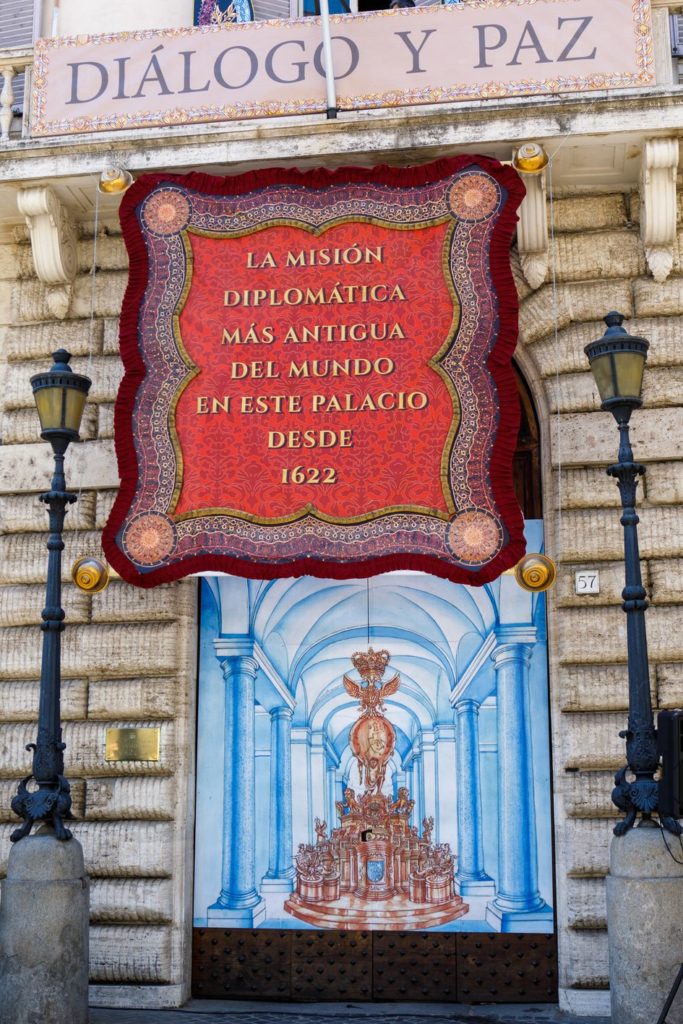To highlight the importance of this building, the IV centenary of its acquisition is being celebrated. The initiative includes a series of activities organized by the Embassy to commemorate this important anniversary: conferences, art, music and dance, visits to the building, etc. For the occasion, OMNES has interviewed Patricia Pascual Pérez-Zamora, Head of Communication and Events of the IV Centenary. In addition to presenting the initiatives carried out, she takes us through the history of the presence of the Embassy of Spain to the Holy See in Rome.
The year 2022 marks the 400 years since the Embassy of Spain to the Holy See was installed in the so-called "Palace of Spain"What has been the trajectory of this important presence in Rome?
The Spanish Embassy to the Holy See was created in 1475 by the Catholic Monarchs. Traditionally it is considered that the first permanent Ambassador of the Kingdom of Spain in the Italian peninsula was Gonzalo de Beteta around 1480. In any case, there is evidence of the existence of ambassadors to the Pontifical Court as early as the time of the Hispanic-Visigothic kingdoms.
From the beginning, the Spanish Embassy to the Papal States was in many ways the model of what would become the style of European diplomatic presence at the Papal Court in the 16th, 17th and first half of the 18th centuries. In addition, the Palace was an outstanding exponent of the propagandistic political language and protocol prevailing at the time, as well as a privileged witness and participant in the balance of power between the Bishop of Rome and the other European powers.
How was the acquisition of this complex of buildings where all the ambassadors have lived since the beginning?
The Palace of Spain was rented in 1622 by the Duke of Alburquerque and its purchase was materialized in 1647 by the Count of Oñate, who paid 22,000 Roman escudos of the time. In 1654 the Spanish State acquired it from the latter.
The building rented in 1622 was basically the same as the one built by the architect Carlo Lombardi between 1592 and 1600. The purchase of the Palace by the Count of Oñate entailed a complete remodeling of the building according to the model of cardinal protocol. The work was entrusted to the illustrious architect Francesco Borromini.
Why is it important for Spain to have this presence in Rome?
Historically, because of the importance that Rome and the Holy See had as the main diplomatic center of modern Europe. Today, because of the weight and authority that the Pope has on a global scale as a moral and religious authority. Also, because of the importance and influence that the Spanish church has always had in the development of the Catholic Church.
As the person in charge of communication and events, can you tell us how you have organized the celebrations for this anniversary?
The protagonist of these 400 years is the Palace. The Embassy existed long before as we have seen. We have organized a pluralistic series of commemorative eventsA series of conferences on the relations between Spain and the Holy See during this long period, in collaboration with the EEHAR; the ephemeral on the facade; a renovation of part of the Embassy offices; there will be art, music and dance events; a large institutional event with the Holy See; sectorial visits to the Palace and a commemorative Posta Vaticana stamp.
The building is a treasure of Spanish art and testimony. Why is it important to value this unique heritage in the history of embassies to the Holy See?
Because European culture is essentially a historical culture. That of the city of Rome even more so. Without history it is impossible to understand what Rome and the Holy See mean. The same is true of this palace, which is pure history.
Obviously, the initiative was also born as a reason to "open up" to the city of Rome, is that right?
Indeed. Many of the contemporary "pilgrims" - tourists - pass in front of the Plaza without seeing or hearing. We would like that with these three large banners that can now be seen on the facade, tourists and passersby reflect a little more on the role that the Embassy has played in the historical development of the neighborhood and the square, to which the Palace eventually gave its name.

Can you explain a little about the intention of the artist Roberto Lucifero with his ephemeral device "Barocco digitale"?
Well, the intention has been precisely the one I just mentioned: to serve as a communication tool with the public that does not know the palace and that will not be able to access it because it is an Embassy. We have built a new website and created a QR on the ephemeral art piece, which we hope will serve as a digital form of communication with the public. open the Palace.
It is also a tribute to the Baroque Festival in Rome, in which this Embassy played a fundamental role. The Baroque was the first civilization of the image, says Maurizio Fagliolo. This puts the Baroque in immediate dialogue with the contemporary world.
Three symbolic moments of Spain's presence in Rome have also been recreated: the purchase of the Palace by the Count of Oñate, the portrait of Innocent X by Velázquez and an ephemeral by Claude Lorrain representing the two great Spanish royal houses: the Habsburgs and the Bourbons.









